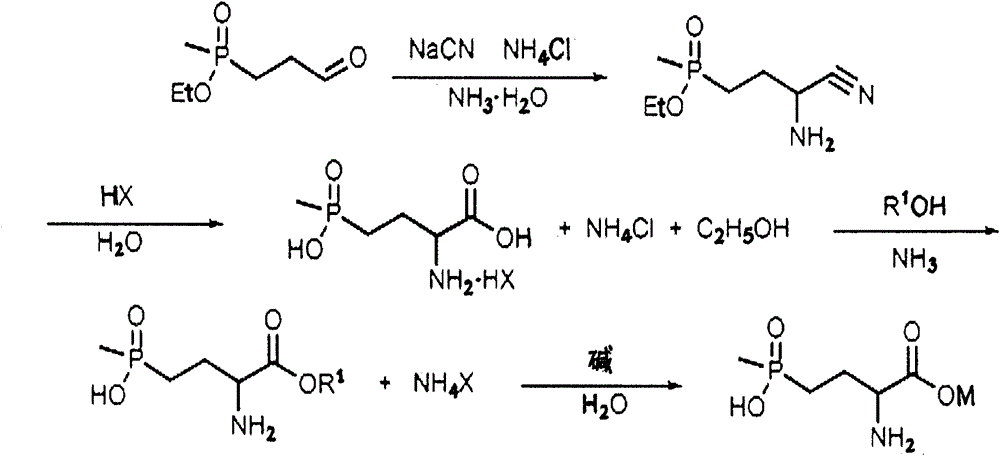New method or preparing glufosinate ammonium salt
A technology of glufosinate-ammonium and ammonium chloride is applied in the field of preparation technology of glufosinate-ammonium salt, which can solve the problems of long route, cumbersome steps, increase cost and the like, and achieve the effects of high industrialization prospect, simple preparation process and economical cost.
- Summary
- Abstract
- Description
- Claims
- Application Information
AI Technical Summary
Benefits of technology
Problems solved by technology
Method used
Image
Examples
Embodiment 1
[0020] Take 34.5g (0.2mol) of methyl phosphonate, under stirring, add to the mixed solution containing 14.8g of sodium cyanide, 22.4g of ammonium chloride, 136g of 15% ammonia water, and react at a temperature of 15°C for 6 hour, then slowly add 120g of 37% hydrochloric acid, heat up to 95°C, react for 4 hours, concentrate the deacidified water under reduced pressure, add 125g of methanol, reflux esterification, the esterification temperature is 70°C, and the esterification time is 5 hours. After the end, cool down to 35°C, pass ammonia until the pH of the reaction solution is 6.5, react for 0.5 hours, then cool down to 10°C, separate and filter the insoluble ammonium chloride, and obtain a methanol solution of glufosinate-ammonium ester. Concentrate under reduced pressure to dealcoholize, add 34g of 10% ammonia water, and carry out ammoniation reaction. The reaction temperature is 5-10°C, and the reaction time is 3 hours. After the reaction, concentrate under reduced pressure,...
Embodiment 2
[0022] Take 34.5g (0.2mol) of methyl phosphonate, under stirring, add to the mixed solution containing 14.8g of sodium cyanide, 22.4g of ammonium chloride, 95g of 22.5% ammonia water, at a temperature of 10°C React for 5 hours, then slowly add 150g of 30% hydrochloric acid, heat up to 90°C, react for 4 hours, concentrate the deacidified water under reduced pressure, add 125g of methanol, reflux esterification, the esterification temperature is 70°C, and the esterification time is 5 hours. After the esterification, cool down to 35°C, pass ammonia until the pH of the reaction solution is 7, react for 0.5 hours, then cool down to 10°C, separate and filter the insoluble ammonium chloride to obtain a methanol solution of glufosinate-ammonium ester. Concentrate under reduced pressure to dealcoholize, add 44g of 8% ammonia water, and carry out ammoniation reaction. The reaction temperature is 5-10°C, and the reaction time is 3 hours. After the reaction, concentrate under reduced press...
Embodiment 3
[0024] Take 34.5g (0.2mol) of methyl phosphonate, under stirring, add to the mixed solution containing 14.8g of sodium cyanide, 22.4g of ammonium chloride, 136g of 15% ammonia water, and react at a temperature of 15°C for 6 hour, then slowly add 120g of 37% hydrochloric acid, heat up to 95°C, react for 4 hours, concentrate the deacidified water under reduced pressure, add 180g of ethanol, reflux esterification, the esterification temperature is 80°C, and the esterification time is 5 hours. After the end, cool down to 35°C, pass ammonia until the pH of the reaction solution is 6.5, react for 0.5 hours, then cool down to 10°C, separate and filter the insoluble ammonium chloride to obtain an ethanol solution of glufosinate-ammonium ester. Concentrate under reduced pressure to dealcoholize, add 34g of 10% ammonia water, and carry out ammoniation reaction. The reaction temperature is 5-10°C, and the reaction time is 3 hours. After the reaction, concentrate under reduced pressure, et...
PUM
 Login to View More
Login to View More Abstract
Description
Claims
Application Information
 Login to View More
Login to View More - R&D
- Intellectual Property
- Life Sciences
- Materials
- Tech Scout
- Unparalleled Data Quality
- Higher Quality Content
- 60% Fewer Hallucinations
Browse by: Latest US Patents, China's latest patents, Technical Efficacy Thesaurus, Application Domain, Technology Topic, Popular Technical Reports.
© 2025 PatSnap. All rights reserved.Legal|Privacy policy|Modern Slavery Act Transparency Statement|Sitemap|About US| Contact US: help@patsnap.com

